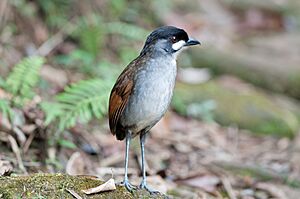Jocotoco antpitta facts for kids
Quick facts for kids Jocotoco antpitta |
|
|---|---|
 |
|
| In Tapichalaca Reserve, Ecuador | |
| Conservation status | |
| Scientific classification | |
| Genus: |
Grallaria
|
| Species: |
ridgelyi
|
 |
|
| Known Ecuadorian range in blue. Now also confirmed from adjacent Peru. | |
The jocotoco antpitta (its scientific name is Grallaria ridgelyi) is a special type of bird called an antpitta. It lives in Ecuador and Peru. This bird is currently endangered, which means there aren't many left. Scientists first found it in 1997 and officially named it in 1999.
Contents
What Does the Jocotoco Antpitta Look Like?
The jocotoco antpitta is a fairly large bird. It weighs about 150 to 200 grams, which is like two small apples. It has a very cool head! You can see white fluffy feathers, almost like little tufts, right under its eyes. Its song sounds a lot like the hooting of a rufous-banded owl.
Family Tree: Who Are Its Relatives?
Scientists group animals based on how closely they are related. The jocotoco antpitta's closest relatives are the chestnut-naped antpitta and the pale-billed antpitta. These three birds share similar features. For example, they all have a plain chest and smoky-grey feathers on their sides.
How Did It Get Its Name?
This bird's scientific name, ridgelyi, honors a famous ornithologist named Robert S. Ridgely. An ornithologist is a scientist who studies birds. Robert Ridgely helped discover this amazing species.
The common name, "jocotoco," comes from the sound the bird makes. It's a local name that sounds like the bird's hooting calls and song. This is called an onomatopoetic name, where the name sounds like the thing it describes.
Where Does the Jocotoco Antpitta Live?
The jocotoco antpitta is found in only a few places. These are in southeastern Ecuador and a nearby part of Peru. Sadly, the number of these birds seems to be going down.
For a long time, people thought they only lived in the upper Chinchipe River area in Zamora-Chinchipe, Ecuador. But in 2006, a new group of them was found in Cordillera del Cóndor in Cajamarca, Peru.
What Kind of Home Does It Like?
This antpitta prefers a very specific type of home. It lives only in wet, mossy forests. These forests must have lots of Chusquea bamboo plants. They also need silvery-leaved Cecropia trees. You can find these birds high up in the mountains, at altitudes of 2,250 to 2,700 meters.
Protecting the Jocotoco Antpitta
Because there are so few jocotoco antpittas, people are working hard to protect them. In 1998, the Tapichalaca Biological Reserve was created. This reserve was set up by the Fundación de Conservación Jocotoco, a group dedicated to saving these birds.
The IUCN (International Union for Conservation of Nature) lists the jocotoco antpitta as endangered. This means it faces a very high risk of disappearing forever. Scientists believe it lives in fewer than five locations. Its habitat is shrinking, and the number of birds is declining. Some groups of these birds are in danger of vanishing completely.
It's possible that the bird is more widespread than we know. This is because it's very shy. Also, its call sounds like a rufous-banded owl, which might confuse people. However, even after searching in many suitable places, scientists haven't found more of them.



